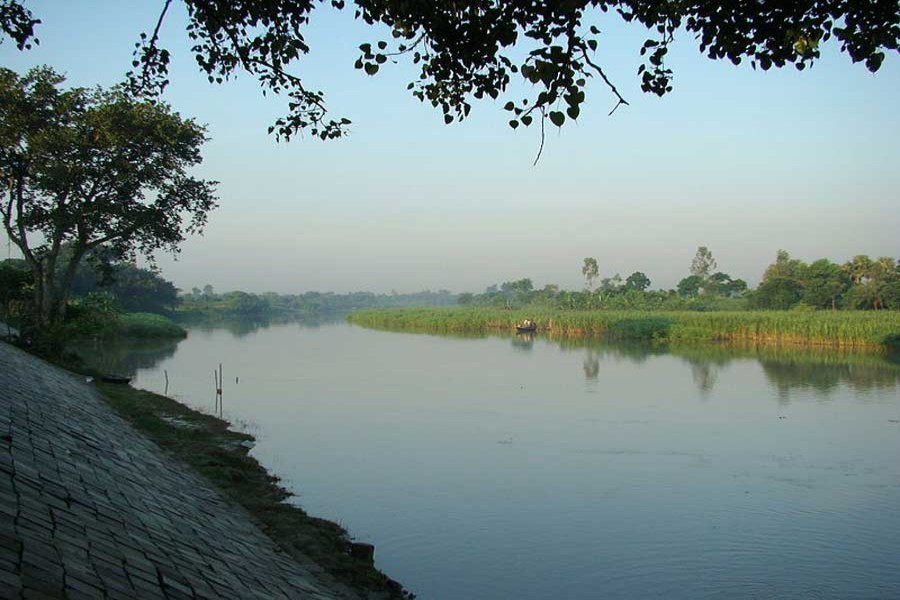Pollution does not stay within man-made borders or wired fences, especially when it's an issue of trans-boundary rivers. Think of a river like a growing child who would eventually want to explore the world. This makes it incredibly difficult to manage such free-flowing rivers with national jurisdiction.
Currently, there are no laws to protect our rivers from the hands of other nations, except one treaty for the Ganges (Padma). The 1996 Ganges Water-sharing Treaty came as the successor of the 'Ganges Water Agreement 1977.'
As participant of the 1972 Stockholm Conference and the Rio Declaration on Environment and Developmentof 1992, Bangladesh signed and pledged to uphold those principles and create laws that have these principles embedded in them.
However, without enforcement the applicability is questionable. Seen as a beacon of light by many, the no-harm principle could have been applied to the 1996 Ganges Treaty, to hold the upstream nation, India, accountable to ensure equitable access to the Padma.
No-harm is a customary international law whereby a country is obligated to make sure that its own developmental activities do not harm the economic, development or environment of another country. Then, to what extent is this practice being applied or related to liability for trans-boundary harm in the Ganges? India has shown a tendency to withdraw river waters, including that of the Ganges,unilaterally. The Supreme Court of Bangladesh had in 2019 given legal rights to all existing river bodies. Imagine, rivers can now take offenders to court just like humans if adversely harmed!
Accordingly, Bangladesh is entitled to use of the Ganges. Hence, the addition of no-harm in the treaty could be sign of hope to allocate waters through cooperation and commitment. Moreover, the idea of no-harm by itself puts an obligation to not directly or indirectly cause harm, as well as safeguard the river ecosystem, which limits the actions taken by India.
Since the construction of Farakka Barrage, located 17 kilometresupstream of Bangladesh near Monohorpur, the Ganges waterflow is entirely controlled by India. The Ganges Treaty acts as if India is a child who can be taught lessons through sessions rather than strict actions. If the Ganges flow decreases substantially at Farraka point, we will be deprived of minimum waters.
According to no-harm principle, the trans-boundary Ganges river belongs to both the upper and lower riparian countries, but the treaty is valid only for 30 years.
With no clear mechanism for dispute solution in place, this treaty does not have the power to control the actions of a big power.
India unilaterally diverts the flows of rivers includingthe Ganges in dry seasons despite crop vulnerability in Bangladesh. Data suggest, Bangladesh is given lesser quantum of watersbetween March 11 and May 10, the crucial season for cultivation. This practice goes against the no-harm law.
India has reportedly launched numerous other dam construction projects over Dudh Kumar, Dharla, Teesta, Gumti, Khowai, Monu, etc. Water flows of Kachu, Muhri, Fulchuri and Chagalnaiyaare already nearing the end.
We also don't see much hope for striking a Teesta water-sharing deal soon. New Delhi is using the excuse of West Bengal Chief Minister Mamata Banerjee'sargument that there is not enough water to be shared.
The dam that has been built over the Teesta in Sikkim, decreases flow of waters downstream. In this case as well, the upstream nation, India, is obligated to share waters with the downstream Bangladesh in accordance with international law.
Some argue that the application of no-harm is unfair towards the upper riparian nations, as any action taken by them will consequently reduce downwards flow and somewhat, end up harming the lower nations. That's not a fair argument when the interests of the lower riparian countries are also involved.
For any Indo-Bangladesh water-sharing agreement, there should be arbitrary mechanism. The no-harm principle should be introduced with legal obligation for enforcement and compensation in place via use of 'polluters pay' principle. And this depends on strong diplomacy.


